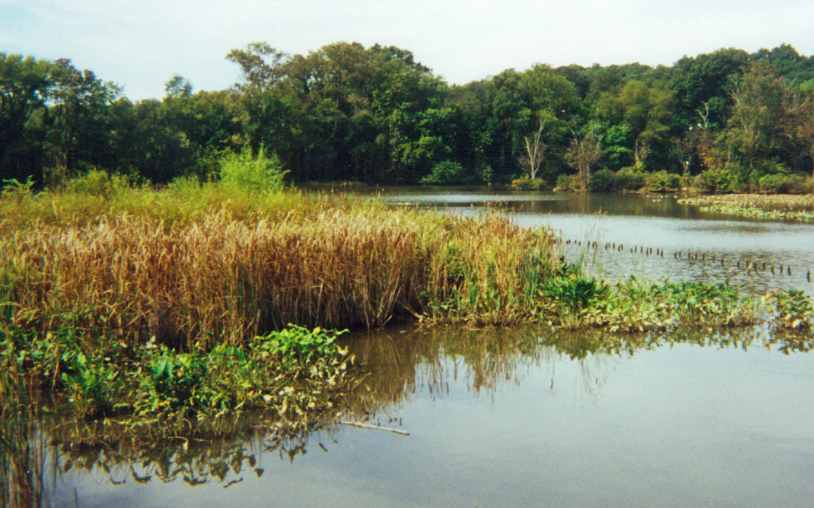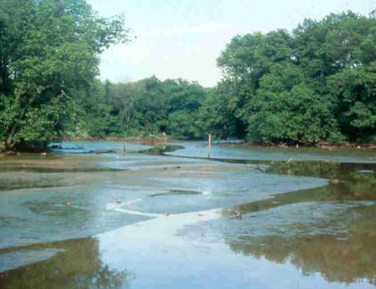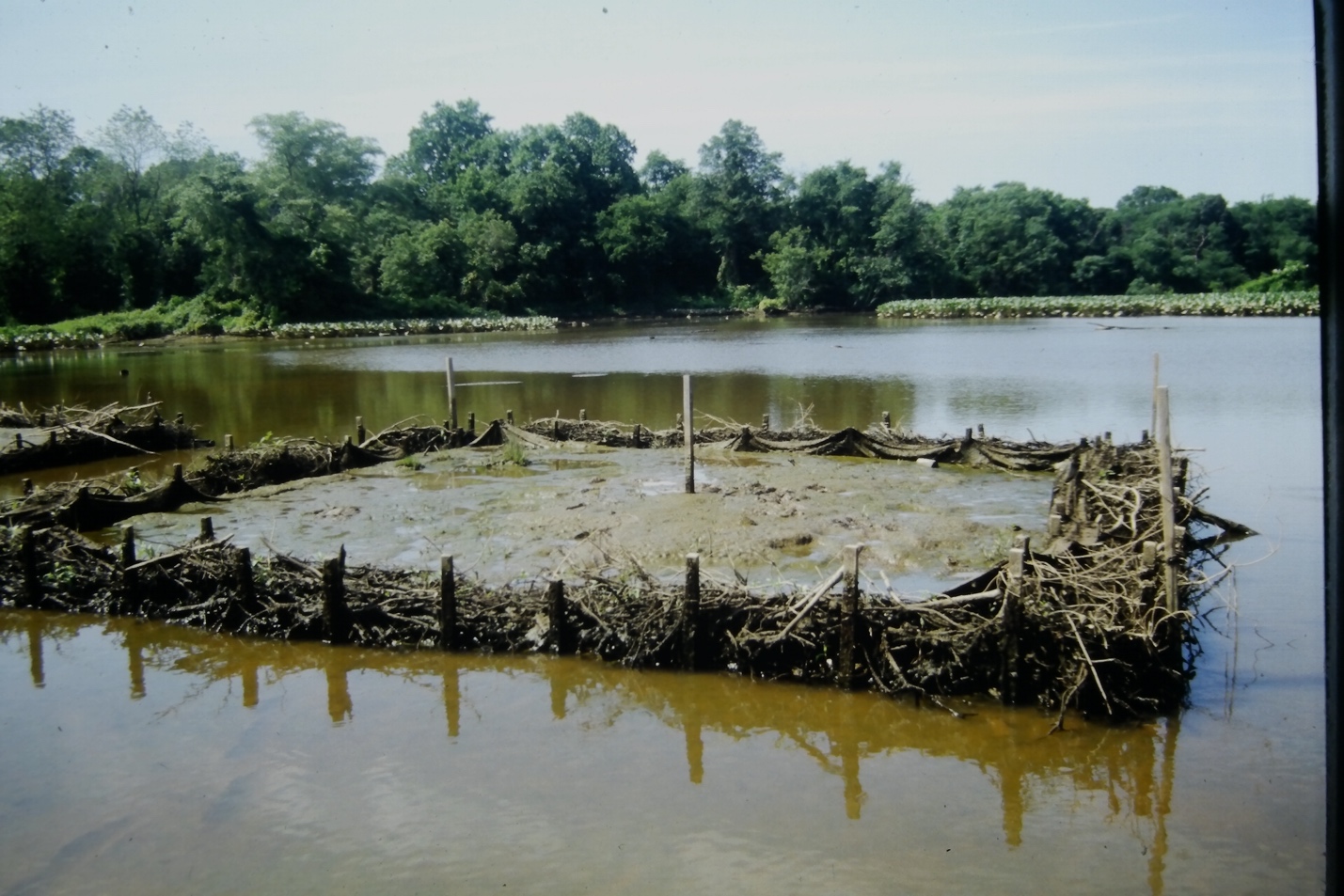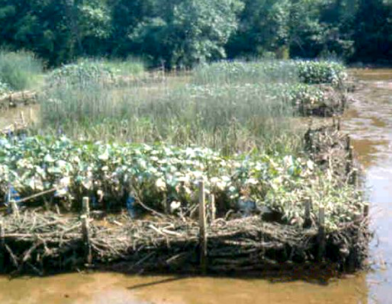Overview
The Kenilworth Marsh tidal wetland restoration project is located in Washington, District of Columbia, United States. The goal of the project was to restore areas degraded from a suite of long-term impacts including river sedimentation, contamination, and channelization. Besides the impacts of altered hydrology on the wetlands, original site substrates and vegetation were buried under dredge spoils and covered with a landfill. Work began with a review of historical changes to the site, assessment of reference conditions, and identification of key factors that restricted the recovery of the wetland. Managers then initiated a pilot study to understand optimal substrate elevations, plant species, and tidal hydrology for facilitating the restoration of the marsh. In the fall of 1992, 130,000 cubic yards of dredged material were used to fill areas in accordance with restoration design elevations. For nearly five months the newly formed marsh substrate was left fallow to allow for dewatering and settlement. At the same time, hydraulically designed tidal channels were cut into the substrate to restore tidal flow back to the system. The following spring, more than 350,000 native plants were installed.
Quick Facts
Project Location:
W373+47 Washington, DC, USA, 38.912804804465, -76.946771686291, 15, GhIJ39ClydZ0Q0AR0BFU6Jc8U8A, Washington, District of Columbia, DC, United States, US
Geographic Region:
North America
Country or Territory:
United States of America
Biome:
Freshwater
Ecosystem:
Freshwater Wetlands
Area being restored:
12 hectares
Project Lead:
U.S. National Park Service
Organization Type:
Governmental Body
Project Partners:
Metropolitan Washington Council of Governments, U.S. Environmental Protection Agency, The District of Columbia, the U.S. Army Corps of Engineers, Washington D.C. Department of Public Works
Location
Project Stage:
Completed
Start Date:
1989
End Date:
1993
Primary Causes of Degradation
Contamination (biological, chemical, physical or radiological), Dams & Hydrology, Fragmentation, Invasive Species (native or non-native pests, pathogens or plants), Urbanization, Transportation & Industry, OtherDegradation Description
Kenilworth Marsh was dredged to create a tidal lagoon connected to the Anacostia River between the 1930’s-1940’s. Around the same time spoils from the dredging of the Anacostia River were placed in Kenilworth Marsh, filling in open water and covering native vegetation. A solid waste landfill also operated in the vicinity of the marsh until 1970. Due to the above-listed disturbances, invasive plant species colonized the marsh leading to further loss of native vegetation and wildlife habitat.
Defining the Reference Ecosystem
The reference ecosystem is primarily based on historical information about ecological attributes at the site prior to degradation.Reference Ecosystem Description
Prior to conducting full scale restoration efforts the project team reviewed historic documents and aerial imagery to determine what previous vegetation and hydrologic features covered Kenilworth Marsh. Subsequently, a pilot project was designed and implemented to test the performance of different plant mixes and containment structures.
Project Goals
Main ecological goals:
Alter species composition (plant, animal, and undesired species)
Increase structural diversity (vegetation, trophic levels, spatial mosaic)
Improve ecosystem function (productivity, habitat, resilience)
Increase external exchanges (habitat links, gene flow, landscape flows)
Remove threats (contamination, invasive species, over-utilization)
Improve physical conditions (substrate physical, substrate chemical, water chemo-physical)
Main social goals:
Enhance community wellbeing
Increase stakeholder awareness and engagement
Knowledge enrichment
Restore natural capital
Monitoring
The project does not have a monitoring plan.
Stakeholders
Stakeholders that were engaged included: local community and project neighbours, nonprofit citizen groups, citizen scientists, land managers, government, and youth. They were engaged to help prioritize distribution of restoration actions on the landscape, help set project goals, objectives, targets, and vision, contribute knowledge on methods and implementation, contribute knowledge about ecological conditions and successional patterns, and engage in participatory monitoring.
The Metropolitan Washington Council of Governments: brought together multitude of agencies to plan restoration priorities, the U.S. Environmental Protection Agency: provided funding & scientific guidance, the U.S. Army Corps of Engineers: provided funding & scientific guidance, and the United States Geological Survey: conducted monitoring & scientific guidance.
How this project eliminated existing threats to the ecosystem:
Installation of goose exclusion fencing to protect plantings from forage.
How this project reinstated appropriate physical conditions (e.g. hydrology, substrate)",:
Placement of dredged material to recontour the site to allow for the restoration of the marsh’s hydraulic function
How this project achieved a desirable species composition:
Installation of containment structures to hold dredged material in place for planting.
Installation of native riparian/wetland species across the disturbed areas to restore biodiversity and improve habitat.
How this project reinstated structural diversity (e.g. strata, faunal food webs, spatial habitat diversity):
Installation of containment structures to hold dredged material in place for planting.
Installation of native riparian/wetland species across the disturbed areas to restore biodiversity and improve habitat.
How this project recovered ecosystem functionality (e.g. nutrient cycling, plant-animal interactions, normal stressors):
Placement of dredged material to recontour the site to allow for the restoration of the marsh’s hydraulic function
Ecological Outcomes Achieved
Reinstate appropriate physical conditions",:
The dredging and recontouring of the site reconnected the natural hydrology of the site.
Achieve a desirable species composition:
Overall, Kenilworth Marsh revegetated extensively and vigorously. During the first year, at least 90% of revegetation areas were covered with dense plant growth averaging several feet in height.
Recover ecosystem functionality:
The restoration also has led to the recolonization of the site with wildlife (particularly bird) species that had not been seen in the area since dredging and landfill activities began.
Socio-Economic & Community Outcomes Achieved
Key Lessons Learned
Monitoring has not shown a significant improvement in water quality. This is likely due to the overwhelming tidal influence of the adjacent Anacostia River, which remains contaminated with pollutants. To increase the effectiveness of the freshwater tidal marsh in improving water quality throughout the Anacostia watershed, more acres of wetland restoration are necessary.
Long-Term Management
One objective of monitoring was to determine if reconstruction of the wetlands had a detectable effect or impact on the water quality of the marsh system and possibly even the nearby Anacostia during the five-year post-reconstruction period. Water quality at Kenilworth Marsh was measured and analyzed for differences and trends within the marsh for five years after the marsh was reconstructed (1993-97), for changes in relation to the adjacent Anacostia mainstem (as a control) for this same five-year period. and for changes in relation to the mainstem and pre-marsh (then consisting of open water tidal flats) for the five-year pre-reconstruction period (1988-92). This data set was intended to serve as a reference for the study sites and study time frame.
In addition to water quality monitoring following the reconstruction, a 5-year monitoring program (begun in 1993) was established to look at the effectiveness of wetland vegetation reestablishment, plant biodiversity, wildlife (including plankton, aquatic macro-invertebrates, mammals, birds, and fish) productivity and utilization, the stability of sediment and development of soil and hydrologic patterns, and nutrient reduction. Management activities since the reconstruction have mainly consisted of removal of invasive plants, particularly purple loosestrife and phragmites.
Sources and Amounts of Funding
Funding came from the U.S. National Government, through the U.S. Environmental Protection Agency and the U.S. Army Corps of Engineers. The estimated global project cost is between $1,000,000 USD – $2,000,000.
Other Resources
Biohabitats » Kenilworth Marsh Design-Build Tidal Wetland Restoration: https://www.biohabitats.com/project/kenilworth-marsh-design-build-tidal-wetland-restoration/
Innovations in Tidal Marsh Restoration: The Kenilworth Marsh Account on JSTOR: https://www.jstor.org/stable/43440264
Primary Contact
Name:
Mikaila Milton
Affiliation:
National Park Service
City:
Washington
State:
District of Columbia





